Menu
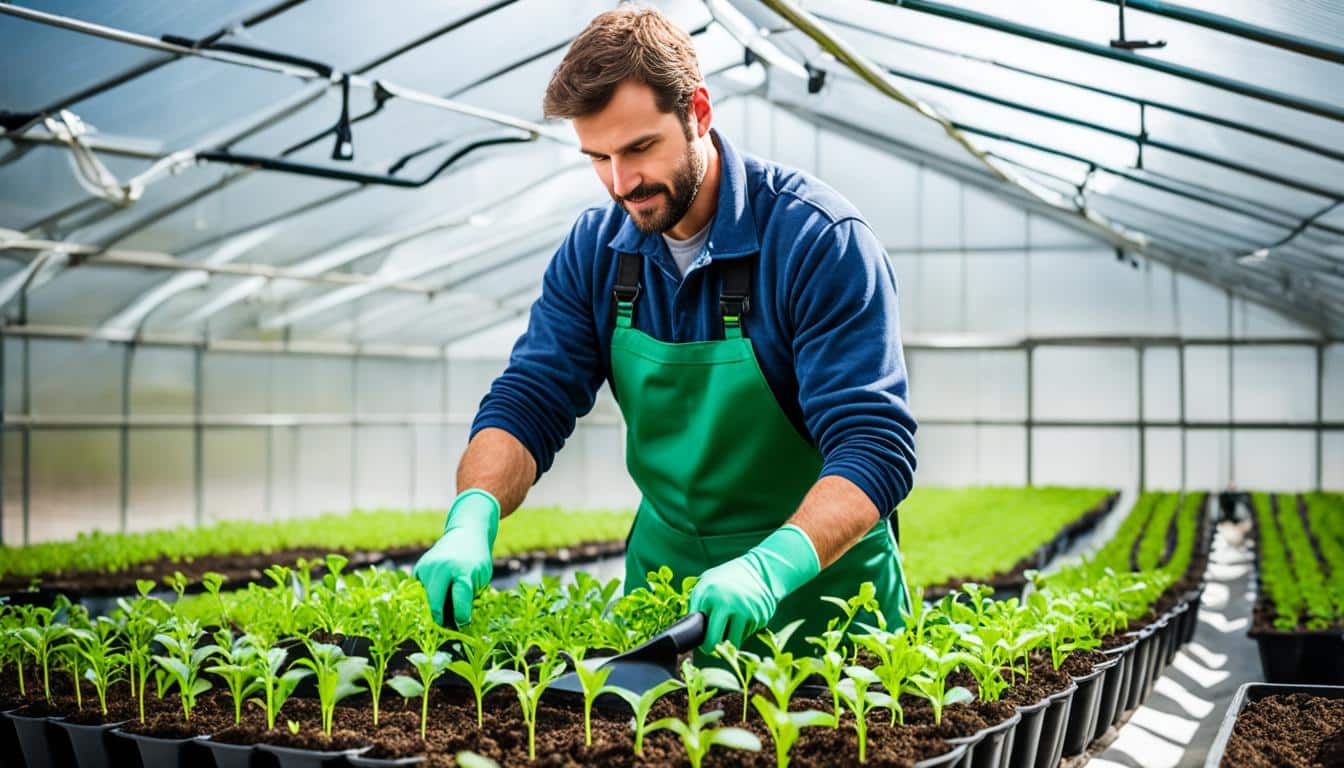
Did you know a greenhouse worker’s hand makes the same motion about 10,000 times in a nine-hour shift? These repetitive motions can cause musculoskeletal disorders (MSDs). This can lead to pain, swelling, and less motion.
The high number of MSDs in greenhouses shows we need better ergonomic solutions. These help work better, feel more comfortable, and be safer.
The 20-8-2 guideline is a great tip for greenhouse workers. It means 20 minutes sitting, 8 minutes standing, and 2 minutes moving or stretching. This helps fight body fatigue.
This, along with having good workstations, can bigly cut the risk of MSDs.
By using ergonomic tips, right material handling, and safety rules, greenhouses can be better places to work. This helps workers do more without hurting themselves. It’s key that workers switch between different positions and stretch often.
Keeping greenhouse workers safe is very important. They face many safety risks in their daily tasks. So, it’s key to have good safety plans in place.
Wearing the right protective gear is crucial for those working in agriculture. Gloves, closed shoes, and long sleeves protect against injuries. They also reduce the risk from chemicals. For tree work, like cutting branches, tougher gear is needed – think leather gloves and boots. It’s vital to keep areas clean to avoid slips and falls, too.
Every greenhouse should have an emergency plan. This plan must detail what to do in bad weather and have first aid kits nearby. Quick action can prevent accidents, keeping everyone safer at work.
Musculoskeletal disorders (MSDs) are a big worry in agriculture because of the hard work. These illnesses affect muscles, tendons, bones, and nerves. Workers need to know the signs and risks to stop long-lasting health problems.
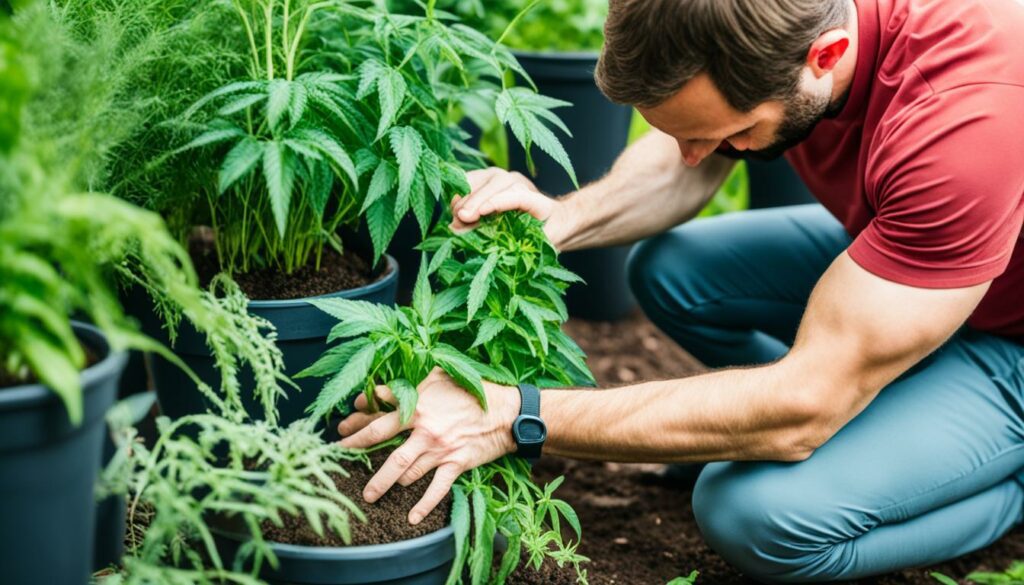
Symptoms of musculoskeletal disorders can show up quickly or slowly. If not treated fast, they can lead to long-term pain. Signs include:
Spotting these symptoms of musculoskeletal disorders early and getting help can lower the chances of big damage.
MSDs in agriculture are usually from several ergonomic risk factors. This can include too much force, doing the same movements over and over, and bad positions. These often happen in jobs like bending down, lifting heavy things, and working a lot with your hands. Key reasons for these issues are:
Doing things to help, like using better tools and stretching often, can make a big difference. Following the 20-8-2 rule, you sit for 20 minutes, stand for 8, and stretch for 2, is good for fighting tiredness and body pain from work in greenhouses.
It’s really important to pin down ergonomic risk factors and MSD dangers for good prevention. Letting your boss know follows safety rules, and it helps stop MSDs affecting how well and how happy workers are.
| Symptoms | Causes |
|---|---|
| Pain, swelling, decreased range of motion, tingling, and numbness | Excessive force, repetition, awkward postures, intensive handwork |
| Chronic pain | Long-term exposure to ergonomic hazards |
Having good posture at work in a greenhouse is key. It helps lessen tiredness and stops health problems like muscle and joint issues. Workers must sit, stand, and move in ways that keep their bodies safe. This stops pain, swelling, and other bad feelings. So, standing and sitting the right way is very important.
Sitting the right way is vital for your body’s health. Make sure your feet are flat and your legs are level, with your body straight. This helps your back and neck feel better. Your arms and hands should be calm. Doing these things in the greenhouse can make work better and more comfortable.
Standing in the greenhouse needs its own special posture. Keep your legs straight but change which foot is up on a footrest. This stops your legs getting too tired. Stand straight and let your shoulders relax to avoid pain. Following these tips cuts down on feeling tired, lessens pain, and makes work go easier.
The 20-8-2 rule in agriculture helps fight tiredness at work and prevents soreness from staying still too long. It recommends sitting for 20 minutes, standing for 8, and doing stretches for 2. This routine boosts blood flow and eases the pain of doing the same things over and over again.
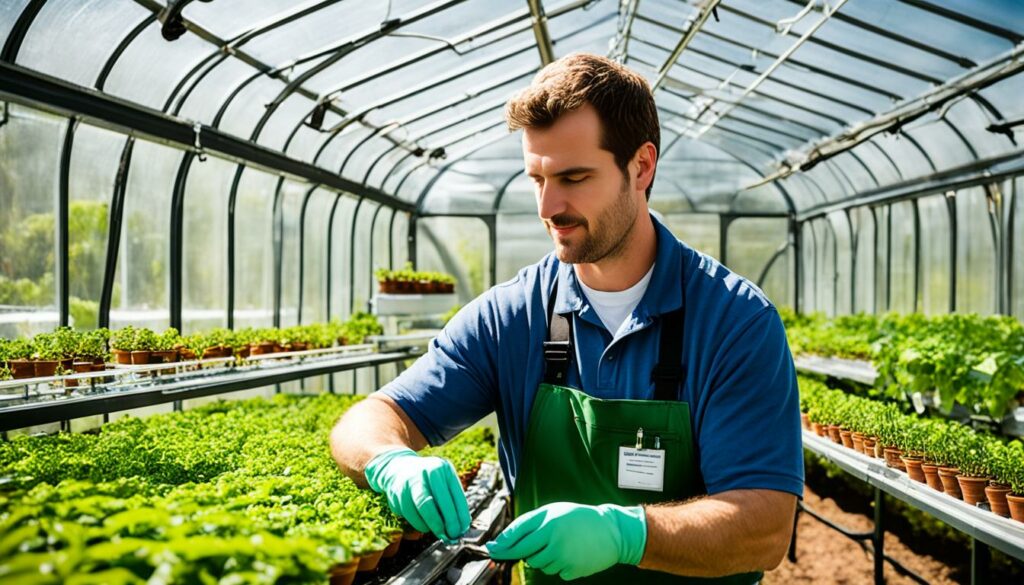
Applying this rule means making small changes in your day. For example, walk when you talk on the phone, have meetings while you stroll, don’t eat at your desk, and change how you sit and stand. These actions support what scientists have found. It shows that changing how we sit, stand, and move a bit helps keep muscle and joint problems away. These problems can make us ache, swell, and move less.
Staying mobile is also key when you’re lifting and moving stuff by hand. This is common in jobs inside greenhouses. By using the 20-8-2 rule, workers can cut down on the pressure and keep in good shape.
Using this rule is like taking a positive step against muscle and joint problems. It means using better ways of working that help everyone feel better in the greenhouse.
Working in horticulture means you deal with a lot of lifting and moving. It’s essential to do this right. Using the correct methods and tools can stop injuries in workers. These injuries are called musculoskeletal disorders (MSDs).
Devices that help with lifting, such as carts and hand trucks, make work easier. It’s key to keep these tools in good shape. Also, don’t put too much weight on them and always watch where you’re going.
Starting with a warm-up is a good idea before lifting anything heavy. Make sure your clothes and shoes give you good support. Always stand with your feet far apart when lifting. Don’t twist your body while moving things. This helps avoid getting hurt.
Stretching is crucial for those working in greenhouses, helping them stay flexible and healthy. Workers often do the same tasks over and over, which can lead to stiffness. Regular stretches combat this, making muscles relax and improving body awareness.
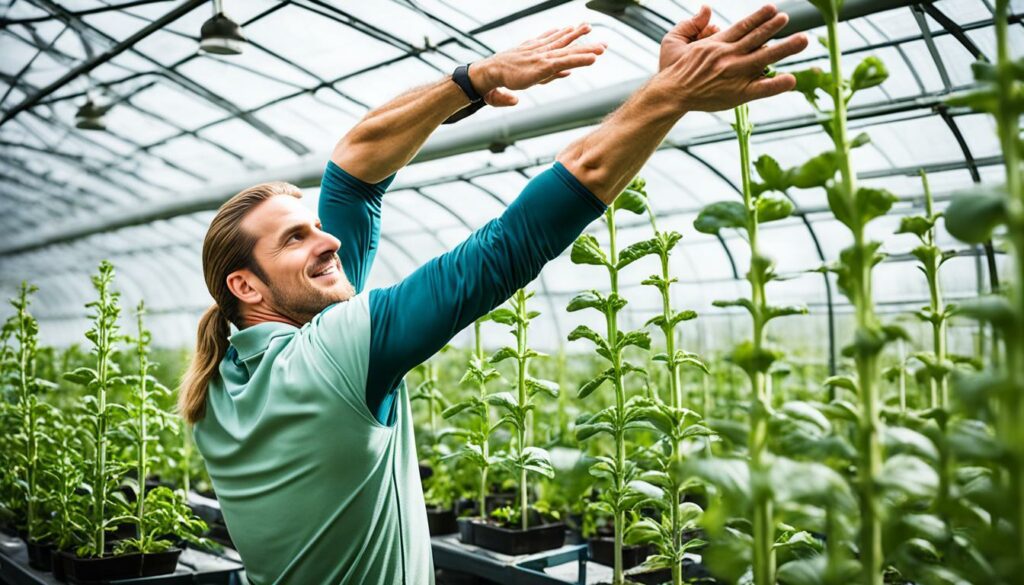
Stretching offers numerous benefits in the horticulture field. It keeps muscles ready for tasks like lifting, pushing, and standing for long. This means less pain, better blood flow, and the ability to move freely. These are key for staying productive and avoiding injury.
| Benefit | Description |
|---|---|
| Increased Flexibility | Regular stretching promotes muscle elasticity, making tasks easier and reducing injury risk. |
| Improved Circulation | Ensures a steady blood flow to muscles, reducing fatigue and enhancing performance. |
| Reduced Muscular Tension | Helps alleviate tightness and discomfort associated with static postures. |
| Enhanced Body Awareness | Encourages mindfulness of physical limits and promotes healthier movement patterns. |
For the best results, focus on specific stretches. Aim for ones that help the areas most used, like the back, shoulders, and legs. Here are a few steps to follow:
To wrap up, these habits not only prevent muscle issues but also enhance working life by boosting flexibility for gardening work.
In the lively world of the greenhouse, it’s vital to think about how we work. This helps to avoid getting hurt in our muscles and bones. Often, doing the same movement over and over or sitting in a weird way causes these issues. You might feel pain, and your body might not move well, or your hands and feet might tingle. So, it’s really important to find smart ways to work comfortably and safely.
Working in a greenhouse can be tough on our bodies. Doing hard, repetitive jobs and sitting or standing awkwardly can be a problem. For example, planting seeds by hand needs lots of the same movements. Doing these actions all day can make you tired and more likely to get hurt. But, if you change how you stand or sit often, it can help you feel better and stop you from getting too worn out. Some people say taking a short break every 20 minutes, standing for 8 minutes, and moving for 2 is a good plan.
We need our work areas to be set up in a way that doesn’t make us strain too much. If you’re typing, the desk should be the right height so your arms are comfy and your neck isn’t getting too tired. If you use your arms a lot, the surface should be lower, which is better for your shoulders. This way, you move and sit in ways that are good for your body.
| Ergonomic Issue | Solution | Benefit |
|---|---|---|
| Excessive Force | Use tools that help | Makes working easier and safer |
| Repetition | Do different things sometimes | Stops your muscles from getting too tired |
| Awkward Postures | Tables and chairs that can change | Makes working more comfy and useful |
Changing up how we do our tasks and where we do them is key. Making tasks simpler by not needing to move your hands so far can really help. This can make a big difference in how tired you get and how much you can do. Also, it’s important not to twist your body in funny ways when working. This can hurt your shoulders and make you less effective.
It’s also valuable to stretch and learn to use both hands for work. Stretching keeps your muscles from tightening up. Using both hands equally might be difficult to learn, but it can help you do your job much faster and without getting hurt.
“Watching how workers stand and move can really make a difference. It helps them stay less tired and work better.”
By using these different ideas together, we can make the greenhouse safer and everyone working in it happier and more productive.
Choosing the right tools for your garden is key for safety and efficiency. Look for ergonomic tools that make work easier and safer. They help reduce the chance of injuries like wrist strain.
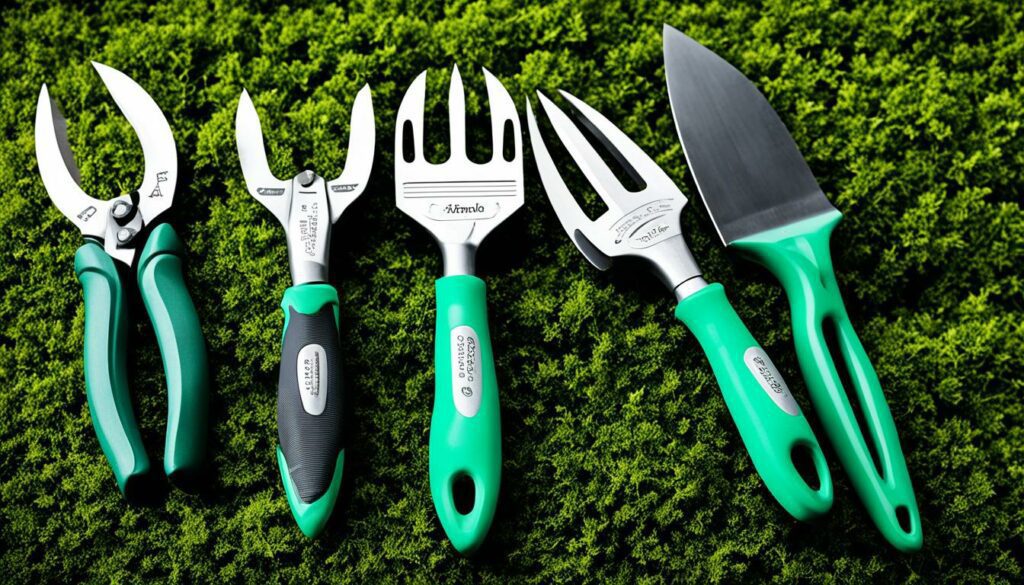
Ergonomic tools can lessen strain and boost performance. They come with handles shaped to reduce wrist and joint stress. Tools with non-slip grips lessen the chance of accidents.
Long-handled tools are also great. They help workers stand straight and avoid bending too much. This cuts down on knee and back injuries.
| Tool | Ergonomic Feature | Benefit |
|---|---|---|
| Pruning Shears | Ergonomically-shaped handles | Reduces wrist strain |
| Hand Trowel | Non-slip grip | Prevents accidental slips |
| Long-Handled Hoe | Extended handle | Reduces back bending |
| Rake | Adjustable height | Minimises shoulder strain |
Taking care of your garden tools is crucial. This keeps them working well and safe. Make sure to regularly check and clean the tools.
Sharp tools do the job better and are safer. Oiling moving parts makes things easier to use. Always use the right tool for the job and wear protective gear.
“Adjusting the layout or workstation design to reduce hand movement distance can result in reducing overall hand movement by 1 mile per worker per day.”
By following these tips every day, your greenhouse will become a better place to work. You’ll keep your tools in great shape and your team safe and happy.
It’s key to make greenhouses comfy and efficient for work. Using the right ergonomic tools is vital for worker health, keeps MSDs in check, and makes work better.
Good chairs and benches in greenhouses are important. They need to fit well and support the back. This helps people sit naturally, reducing back strain.
Seating should be adjustable. This means the height and tilt can be changed. It makes different tasks easier and can prevent discomfort when sitting for a long time.
Moving furniture in greenhouses can help keep it ergonomically sound. Workers can change the furniture to fit their height and task. For example, the table should be level with the elbow for typing. This stops people from getting tired too quickly.
Working with either hand is another smart move. It might be hard at first but can make work faster and easier. Arranging things to reduce how much people move their hands helps a lot too. If the distance your hand moves drops from 12 inches to 6 inches, imagine how much time you save over a day!
| Feature | Benefits |
|---|---|
| Adjustable Workstations | Accommodates various tasks and worker heights, reducing fatigue |
| Ergonomic Chairs and Benches | Supports proper posture, preventing MSDs |
| Ambidextrous Work Practices | Increases productivity without additional strain |
Keeping greenhouse workers healthy is vital for their wellbeing. This starts with putting strong health protection steps in place. Employers in Ontario must follow the Occupational Health and Safety Act, 25(2)(h). They need to do everything they can to keep their workers safe from risks. This includes risks that may lead to muscle and bone problems (MSDs).
Using preventative strategies for worker health helps cut down on costs. These costs include lost work time, making insurance claims, higher insurance costs, and hiring and training new staff. Programs to prevent MSDs are focused on avoiding these problems. They make work safer and more productive.

Employers must also make sure all tools, materials, and safety equipment are in good condition (OHSA Clause 25(1)(b)). It’s key that a greenhouse’s health and safety team or chosen representatives check them once a month. These checks find and fix health and safety issues, including those leading to MSDs.
Ergonomics plays a big role in dealing with MSD dangers in greenhouses. It focuses on making injuries from overusing muscles and tissues less likely. For example, workstations can be made to adjust to different heights. This helps with tasks like sleeving and rose bunching. Using raised troughs makes working heights better. These changes not only make work better but also lower the chances of MSDs. Adding controls on how work is done, like changing working hours or switching jobs, also helps a lot.
Workers have a big part in making sure greenhouses are safe places to work. They do this by learning about safety, following safe work ways, watching for MSD dangers, and telling their boss if they feel not well. They should change jobs during the day to avoid doing the same thing over and over.
Taking breaks is also important to rest. The Canadian government’s rules on staying safe at work say clearly what needs to be done to stop muscle and bone injuries (Part XIX). This highlights how vital it is to act before problems show up.
I think it’s essential for employers and workers to work together. Doing so makes the workplace safer, more productive, and comfortable. This ensures that looking after people’s wellbeing at work is always a top concern.
Improving how we do tasks with ergonomics is really about changing how we do things. It focuses on making work healthier and more productive. This is crucial where people do the same movements over and over or need to sit for a long time.
Mixing up jobs can make things run much better. It lowers the chance of getting hurt doing the same thing all the time. For example, if workers switch between planting and fixing the greenhouse, it’s better for their bodies. They use different muscles and don’t tire out one side too much.
Organising work time well is key. It’s best to do tasks when people have the most energy. When it comes to breaks, they should be built into the day for moving around and changing how they sit or stand. This stops tiredness from staying in one position too long. Sharing different jobs also keeps things fresh and cuts the risk of injury.
Taking regular breaks stops workers from getting hurt and helps them work better. They should follow a pattern called the 20-8-2 rule. This means sitting for 20 minutes, standing for 8, and stretching for 2. It keeps blood moving and fights tiredness.
It’s also vital to have good break times for people lifting or bending a lot. Short breaks often are great for helping them recover. Doing this helps keep the work smooth and healthy for everyone.
Rotating tasks and scheduling breaks properly are key. They make the greenhouse a place where people can work safely and well.
Tasks like harvesting, weeding, and pruning happen a lot in greenhouses. They can lead to musculoskeletal disorders (MSDs). These issues come from lots of lifting and carrying, sometimes in tricky positions. A person working on a transplant line may repeat the same action every 3-4 seconds. This can lead to 10,000 repetitions in a 9-hour day. Such high numbers can cause injuries, costing the industry a lot of money. They also make greenhouse work seem very physically tough.
Greenhouse jobs that are repetitive can really affect health and work efficiency. Making small changes, like adjusting the table to the right height, can reduce stress. But, tasks that make you reach across your body should be avoided. They can hurt your shoulders and make you less productive.
There are ways to deal with the impact of repetitive work. Learning to use both hands can make someone much more productive. Yet, it takes training from someone who knows. Also, looking at how workers sit or move can really help. For instance, changing the desk setup can cut down how much people’s hands move by a lot per day.
Changing small things in how tasks are done, like not crossing your hands, can make a big difference. These tweaks can lower stress and make work more efficient. Companies should try to make these changes as they add up to a big improvement. For more on how to boost worker productivity, check out this resource.
To make working in greenhouses easier, use adjustable workstations and special tools. Take regular breaks and stretch. Also, sit and stand correctly to help blood flow and cut down on feeling tired.
Workers need gloves, closed-toe shoes, and long sleeves for small cuts and chemicals. For heavier work, like caring for trees, leather gloves and sturdy boots are a must.
The plan should tell where to go if there’s bad weather, provide emergency phone numbers, and show where first aid is kept. Doing practice drills regularly is important to be ready for emergencies.
MSDs can cause pain, swelling, and less movement. You might also feel tingling or parts of your body going numb. These issues can happen all at once or slowly, and they affect muscles, bones, and more.
Greenhouse work can lead to MSDs due to too much force, repeating the same movements, and holding odd positions. Things like bending, lifting, and doing lots of work with your hands can all be major factors.
Sitting right means keeping feet flat, legs level, and back straight. Also, keep arms and wrists in a natural position. This stops you from getting uncomfortable and helps you work better.
When standing, make sure to keep legs straight and maybe use something to rest your feet on. Also, stand up straight, have your shoulders relaxed, and keep your elbows close. This stops MSDs from starting and makes you more comfortable.
Spend 20 minutes sitting, 8 minutes standing, and 2 minutes stretching to avoid getting too tired. This routine is good for staying comfortable and working better in greenhouses.
Follow these tips for picking things up to stay safe: use carts or hand trucks, don’t carry too much, and see where you’re going. You should also warm up first and avoid twisting your body. What you wear and your shoes also matter a lot.
Stretching often makes you feel better when you have to sit or do the same thing over and over. It helps your muscles relax and keeps your body moving well. This all means fewer injuries and more work gets done.
Fix everyday problems with the way people work by changing how the work area is set up. Make sure it’s easy to move around and fits different people. Varying the tasks also helps avoid bad effects on the body.
Choose tools that are made to be easy on your body to lower the risk of getting hurt. It’s also important to look after these tools well and use them safely so they last longer.
Furniture that’s made well helps you sit and stand correctly, making it less likely you’ll get sick from bad posture. It should be adjustable to fit your job and your size, which makes you work better.
Keep workers safe and healthy by stretching, wearing the right gear, and teaching them about risks. Talking openly about how they feel and knowing the signs of MSDs is also very important for everyone’s safety and health.
Doing things in a way that’s good for your body and switching tasks often makes you less tired. It also means you’re less likely to get hurt. This keeps work going well.
Tasks like harvesting, weeding, and pruning can be hard on your body from doing them again and again. But, using the right tools, taking regular breaks, and picking up things with long handles helps make them easier.